If you are a horse owner, sooner or later you’re going to need to trailer your horse somewhere. It could be that you’re headed off to a horse show, going out for a relaxing trail ride or a weekend camping trip, or it could be for a veterinarian or farrier appointment. Knowing how to safely trailer your horse is important for any horse owner, and proper planning and preparation before the trip will help you arrive safely to your destination. Whether you’ve been transporting your horse for years in your trailer or you are new to trailering your horse, there are important steps you’ll need to take to prepare for hauling your horse. Even if you put your trailer away last fall in perfect condition, you’ll still need to conduct safety checks before you drive away with your horse inside. The extra time that you spend checking that you’re safely trailering your horse will make the ride more relaxing and enjoyable for both of you. Your trailer’s owner manual will give you a very specific list of maintenance tasks that you’ll need to do at certain time periods, but here is a general overview of things you’ll need to do to help keep your trailer in good condition. After all, with your precious cargo inside your trailer, you want to make sure you’ve taken all the necessary precautions for safely trailering your horse.
Inside The Trailer
First, take a look inside your horse trailer. Your trailer should be designed for comfort and safety, and needs to be the correct length, width and height to accommodate the breed and size of your horse. A stout draft horse that is 17 hands high, for example, is going to need a lot more room than a smaller sized pony. In addition to ample space, your trailer needs to have strong floors, soft padding and good ventilation in order for your horse to travel comfortably.
One of the most important tips to safely trailering your horse is to make sure the flooring is safe and secure. The floor of your trailer needs to be routinely cleaned after each use, since the accumulation of urine and manure can easily rot wood flooring or corrode aluminum floors. Most people cover their trailer floors with rubber mats, shavings or straw for extra comfort and absorbency. However, urine or water can easily become trapped under these materials, so you’ll want to make it a regular habit to remove them and thoroughly clean and inspect the trailer floor for signs of wear or damage. If you have wood floors, you can carefully use a screwdriver to check for soft spots in the wood, paying extra attention to the edges where urine or manure can easily accumulate. If you suspect that your trailer floor is showing any signs of wear or weakness, get it professionally checked and replace the floor if needed – the last thing you want is for your horse to put his foot through a weak, damaged floor.
Check the doors, windows and partitions inside your horse trailer and make sure they easily open and close. You might need to lubricate the moving parts to keep them working at their best. Check the hinges, springs and latches to make sure they are working properly and replace any parts that are broken or missing. Most trailers have padding on the walls, stall dividers and butt bars, so you’ll want to check the padding and make sure it’s in good condition. Check for tears or rips in the padding and have it replaced if you do find any damage. The padding not only provides extra comfort for your horse, but it can help to prevent injury in case of a sudden stop or accident.
You’ll also want to check the ventilation inside your horse trailer, since proper air flow is important for the health and comfort of your horse. Your horse trailer should have overhead, side and rear door vents so that the air can circulate and move freely throughout the trailer. Check all the vents and screens to make sure they aren’t clogged with dirt and check that the vents can easily open and close. If you find any rips or tears in the window screens, have them replaced so that debris or small rocks do not enter the trailer through the windows while you are transporting your horse.
While you’re inside the trailer, check around to make sure there aren’t any bees or wasps nests that appeared since your last ride. Also, look around for any bolts, screws or nails that may have become loose or are sticking out, and remove and replace any loose or missing parts that you find. Check the hay bags and remove any moldy hay from the bags; also check that the hay bags or feed mangers are securely fastened so that your horse can’t get tangled or injured.
If your trailer has living quarters, fill up your propane tank and check that the spare tanks are in good working condition. Also make sure that the heating, air conditioning and appliances are clean and function properly before you leave on your trip.
Outside the Trailer
Walk around the outside of your trailer and check the frame for any signs of rust or cracks, and repair or replace any rusted or damaged parts. Check that the trailer ramp, side doors and drop-downs are all in good working order and check the hinges for any signs of cracks or weakness and, if needed, lubricate the hinges so that they open and close easily. Look closely at your trailer ramp and check for signs of wear or damage; if the ramp flexes more than it used to, it’s probably time to have it professionally inspected and replaced.
If your trailer has a water tank or overhead hay rack, clean them both thoroughly before your trip. Make sure that the water tank does not have any algae growing in it, and that the water is clean; remove any old, moldy hay from the hay rack so that the hay that you’re bringing along on the trip is fresh.
Next, check the tire pressure and the condition of your tires. It’s important that you know the age of your tires because even though the tread may not look worn, old tires can develop dry rot or other problems and should be regularly inspected and replaced as needed. You’ll want to check with your manufacturer’s recommendation, but many manufacturers recommend that you replace the tires every five years (this can vary depending on how much you use your trailer). Check the tire pressure in your truck, trailer and also in your spare tires. If your trailer has been sitting all winter, there’s a good chance that the tire pressure is low. On most trailers, you’ll find the manufacturer’s recommended tire pressure printed on the frame on the driver’s side towards the front of the trailer. Look at your tires for any obvious dangers such as nails or problems with the treads and sidewalls, and also make sure that the lug nuts are tight on all of the wheels.
Next, make sure that the lights and the brakes are working properly on both your tow vehicle and your trailer. Having the lights and the brakes in top working condition is critical to the safety of both you and your horse. You may need to brake suddenly during your drive, or use your lights to signal a lane change or keep on while you’re driving, so spend some extra time and ensure that both are working properly.
Lights – Check the electrical connector that links the lights of your trailer to your tow vehicle, looking to see that the wires are not frayed, loose or damaged. Hook your tow vehicle to your trailer and turn the lights on – this is the easiest way to see if the lights are working correctly. You’ll want to test all of the lights (you can even have a friend help you), making sure that the turn signal lights, running lights, brake lights and hazard lights are all functioning properly. Also, check inside the trailer to make sure the interior lights are working, too. If any of the bulbs are missing or broken, you’ll need to replace them so that your trailer is safely lit.
Brakes – You’ll want to check that your trailer’s breakaway system is properly working; this system is designed to safely stop your trailer should it somehow become disconnected from your tow vehicle while you’re driving. If your breakaway is working correctly, the moment your trailer disconnects from your tow vehicle the pin pulls out of the switch and engages the electrical brakes, which will then stop your trailer. This, obviously, could be a lifesaver for your precious cargo inside. At the front of your trailer there is a plastic case that holds a 12 volt battery and you’ll want to check to make sure that the battery is fully charged. When you’re not using your trailer, you still want to keep the pin intact – if for some reason the pin has been pulled, the battery can quickly be depleted.
Next, check your trailer hitch and safety chains and look for any signs of rust, wear or hairline cracks. Always use the proper size ball and check that it fits correctly; also, if the ball is dry, it could be hard to hitch and unhitch your trailer, so you might need to lubricate it occasionally. When you’re not using your horse trailer, you might want to protect your hitch with a trailer hitch cover.
Trailering Your Horse
Before you leave on your trip, make sure that you’re well supplied for your travels. You’ll want to make sure you leave with a well-stocked trailer with extra supplies, such as safety triangles and first aid kits, as well as extra food and water for both you and your horse. Here is a list you can print out for some ideas on what you might want to bring. Depending on your personal preferences, where you are headed and how long you’ll be gone, you can customize this list as needed.
Traveling in a trailer can be stressful for some horses, so make sure that your horse is familiar and comfortable with trailering well in advance of any trip. Even if you don’t travel that often, practice loading and trailering your horse (even if it’s just around your local neighborhood) as a sort of refresher course for your horse.
When you’re ready to leave on your trip, load your horse and do one more basic safety check. Make sure the ventilation is good, and double check that all doors, ramps and dividers are closed and secure. Once you’re on the road with your horse, remember that you’re pulling a large load so it will take you extra time to stop. Always drive with your horse in mind, meaning that you’ll need to gradually accelerate and brake. Keep plenty of distance between you and other vehicles so you don’t have to make any sudden stops or sharp turns. The weight of your horse plus the weight of your trailer will push against your towing vehicle, so drive carefully and defensively.
If you’re traveling for any extended amount of time, stop every few hours to let your horse rest and relax, offering him fresh water to drink during the stops. Ideally, you brought along water from home in a familiar bucket so your horse will be more likely to drink. Keep some hay in his hay manger or hay net – munching on hay is a great way for your horse to keep busy while he’s traveling in the trailer.
After you’ve finished your trip, unplug the trailer’s electric connector and put chocks behind the wheels to help keep your trailer from rolling. You’ll want to muck out the trailer and remove the soiled bedding from the trailer. If you use rubber mats, take them out and rinse them off with water – then let them thoroughly dry. Once the floor and mats are completely dry, you can then close all of the windows and vents.
It may take some extra time and planning, but taking a few extra precautions and checking your horse trailer before you leave on any trip is very important. During the year, you’ll also want to bring your trailer in for regular maintenance and check ups, and if you have any questions about how to safely trailer your horse, you can always ask your trailer manufacturer questions or discuss specific concerns that you may have. Do you have any safety tips on trailering your horse?

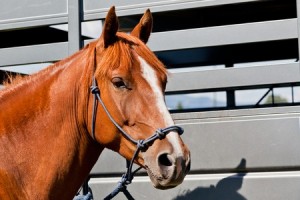
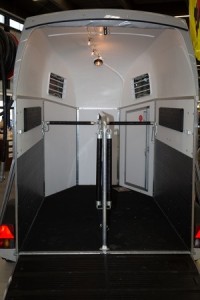
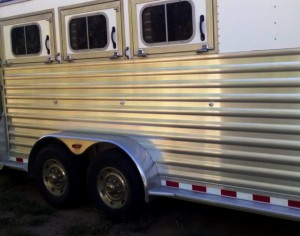
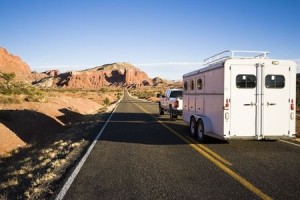


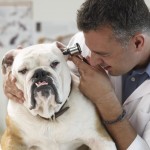

Alix says
I am going to be picking up a young OTTB from west Virginia which is over 2 hours away what supplies will my horse need during shipping?